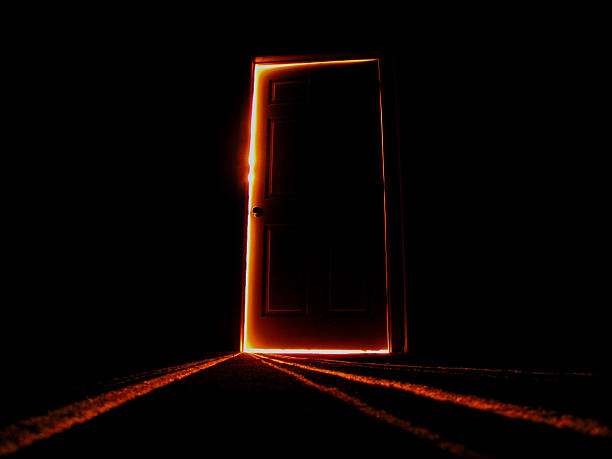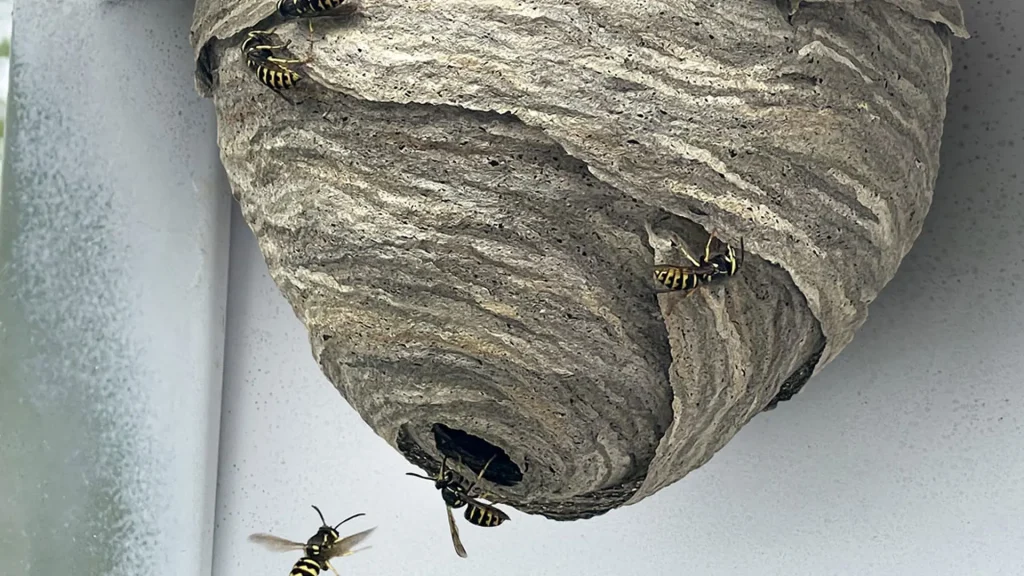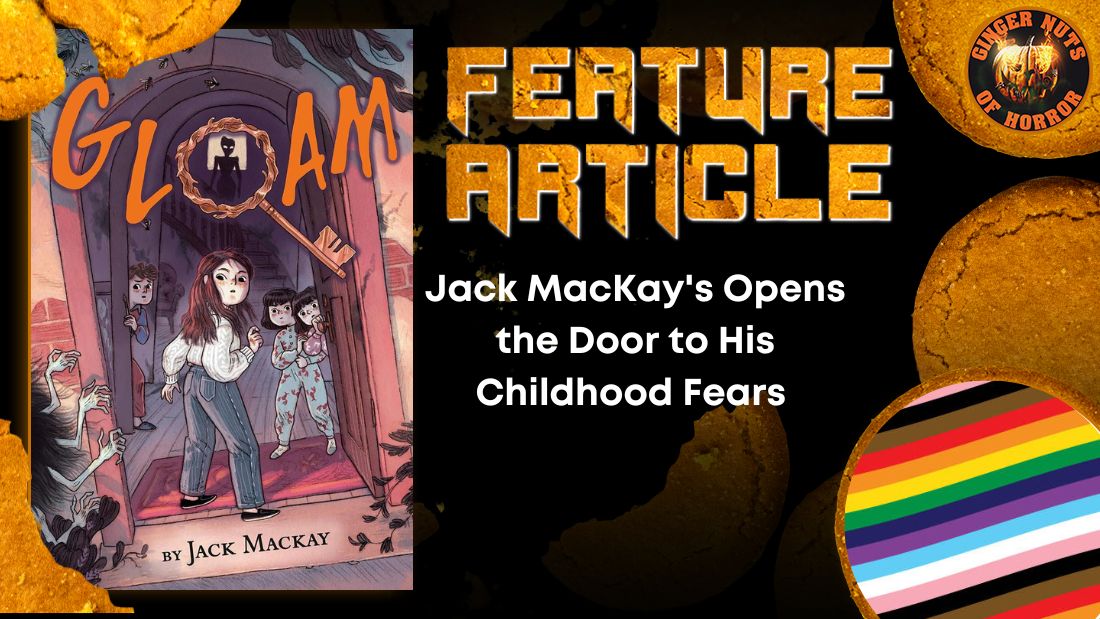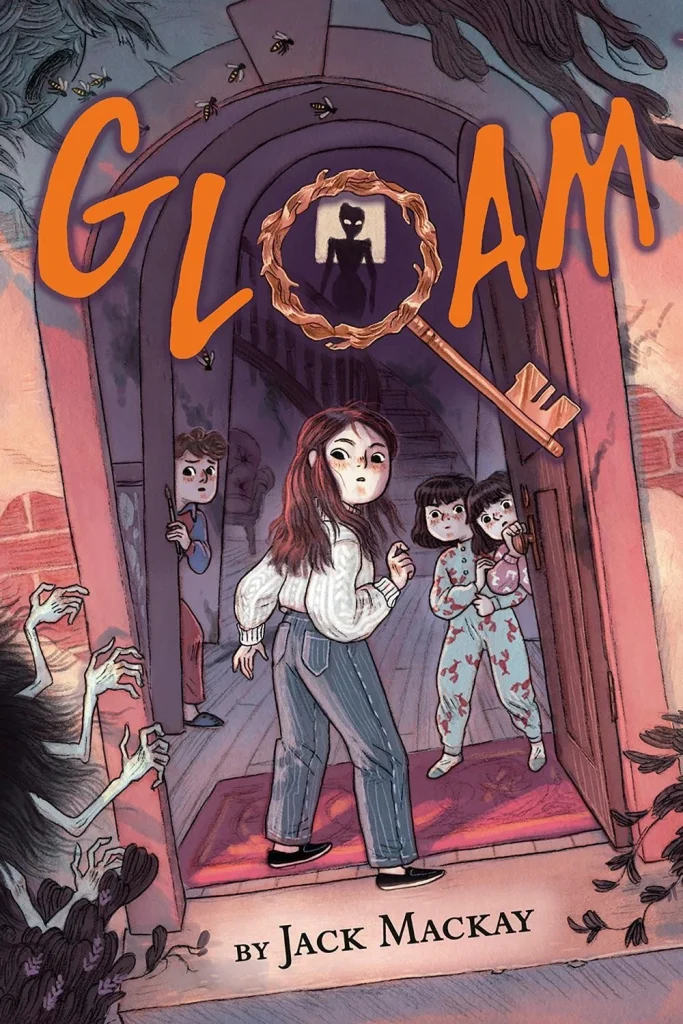To celebrate the launch of Gloam by Jack MacKay, we welcome Jack to Ginger Nuts of Horror with a brillaint entry in our Childhood Fears series of articles. Described as “Featuring a bold and tenacious protagonist, a supporting cast of instantly endearing characters, and a veritable phantasmagoria of ghastly ghouls, debut author Mackay delivers a classic tale of children’s horror that’s as chilling as it is heartfelt.” by Booklist.
Jack MacKay’s Childhood Fears Explained
Gloam is scary because it’s full of my own fears, but Gloam isn’t for me, not really. Above all, it’s for young readers. Writing horror for young people is not just about exorcising your childhood demons. It’s about revealing a part of your soul that you hope a child might recognise and realise, “wow, I’m not alone.”
There is a corridor in my grandparents’ house. The corridor is very long, and has only one door, which leads to the left, into my grandparents’ bedroom. The landing light does not fullyreach the end of this corridor, so the bookshelf and mirror on the far wall are always slightly shrouded in shadow. As you climb the stairs to the second-floor landing, you emerge, step-by-step, directly opposite this corridor. With each step, it slowly reveals itself until you can see straight down it.
I have been frightened of this corridor ever since, when I was less than ten years old, my errant imagination conjured possibly the most blood-curdling image I have ever inadvertently subjected myself to. Even now, at twenty-two years old, my toes curl a little when I imagine it, especially if I happen to be climbing those stairs and staring down that corridor when it’s dark. It goes like this.
I imagine myself walking up the stairs to my bedroom on the third floor. Inch by inch, the corridor reveals itself, like a camera panning down. Its depths are a rectangular cauldron of darkness, but I can make out the edge of the doorframe to the left, though I cannot see the room beyond. Normally, when I walk past this corridor, it is empty. Tonight, in blackest night, believing myself alone in the house, I climb the stairs, and stop dead still on the top step.
My own face reflected in the mirror is not the only face in that corridor. There is another face.

Half-hidden, it is peering around the doorframe at me, low to the ground, too low, as if the thing the face belongs to is crouching unseen behind the door. I cannot make out the details, but it has long, stringy hair, and its eyes are wide and white and staring. It is looking at me. I am looking at it. This moment has no resolution. It lasts for eternity, frozen in time, because I know that it – whatever it is – has seen me, and if I move, something unspeakable will happen.
There you are. Now that nightmare is yours.
Most fans of horror I’ve met are scaredy cats. It makes sense. The thrill of horror is in being frightened, of hiding behind your pillow, of seeing terrifying faces in the dark in the small hours when you should be asleep. The more in touch you are with this feeling, the more you give yourself over to a work of horror-art and trust it enough to scare you, the greater the impact it has.
It’s some of the greatest fun you can have, but it’s more than just fun. In the best cases, where a piece of horror fiction has worked its terrible beautiful magic, you feel as if you’ve been handed a key to a tiny, secret door in the very centre of your soul. The exciting, terrifying question is: “What’s behind the door?”
Some of the most easily frightened people in the world are kids. I do not mean this in a disparaging way. Quite the opposite. Young people are tuned into their senses in a way that I already, being only four years into my adulthood, yearn to experience again. Horror fiction reminds adults of how it feels to be afraid to leave our feet hanging over the edge of the bed, but that fear is a daily (nightly) reality for young people. The comforting adult realities of statistics and logic and disbelief in magic are barely half-formed in their minds.
Instead, the tantalizing questions linger. What if my family are not sleeping in the next room, but have actually disappeared without a trace, leaving me all alone? What if that creak in the hallway wasn’t just the house settling, but something moving about in the dark? What if there really is something looking at me through my window right now?
What’s behind the door?
This is the primal part of yourself you have to dig for when you’re a horror fan, especially when you’re writing horror, and double especially when you’re writing horror for children. You ask yourself what kids find scary, and the answer usually comes from what you found scary when you were that age. It only takes a few moments for the cobwebs to clear, and that image you thought you’d forgotten but had really kept locked behind that little soul-door comes swimming up out of the dark and blooms in your mind like you saw it only yesterday.
My debut novel, Gloam, is basically Childhood Fears: The Book. It follows four siblings – a thirteen-year-old, a ten-year-old and two six-year-old twins – and their nightmares which manifest in real life after the arrival of their sinister new babysitter. To write it, I put myself in their positions and tried to remember what I’d be scared of in their position. Inevitably, their fears became my own – or rather, my fears became theirs.
The Corridor appears early in the book. I don’t exactly recreate the scenario from the start of this post (and I’m not sure I’d want to), but it has its echoes. The corridor itself plays a pivotal role in the manifestation of the twins’ deepest fear. It’s not the corridor itself that frightens them, but what lies beyond the corridor, beyond that door, out of sight. The corridor is only a dreadful prelude to the unknown.
Other childhood fears returned to me as I wrote. When I was about five, I was playing in the treehouse that my grandad built for me. I played for about ten minutes before I saw what seemed to be a basketball-sized lump of tissue paper lodged in the crook of the roof.

It was a wasp’s nest, and by the time I’d bolted out of the treehouse, I had been stung once on the ankle and once on the buttock (turns out wasps can sting through shorts). My mum and grandma tended to my wounds as I cried, and for years afterwards the mere presence of a wasp would cause me either to freeze in place like a guilty racoon, or run as far as I could possibly get away.
I remember this moment in stark clarity, and though wasps and I are no longer bitter enemies (recently, while eating lunch outdoors, I even saved one from drowning in my pot of maple syrup) this episode forms the basis of ten-year-old Roger’s character in Gloam, and the monster that awaits him in the treehouse outside.
Gloam is scary because it’s full of my own fears, but Gloam isn’t for me, not really. Above all, it’s for young readers. Writing horror for young people is not just about exorcising your childhood demons. It’s about revealing a part of your soul that you hope a child might recognise and realise, “wow, I’m not alone.”
This is why I believe horror can be as much a home for children as it is for us grown-ups. Children are no strangers to fear; in fact, they practically have the monopoly on it. Everyone has childhood fears for a reason. But kids don’t want to be patronized, protected, shielded or supervised. They need to be given the agency to face their fears on their own terms. They need confirmation that their nightmares aren’t singularly terrifying, but rather a part of being human.
They need the language to put words to something that they might otherwise be unable to explain, and therefore infinitely more nebulous and frightening. They want to know what’s behind the door, because behind the door might be something they never knew about themselves. That’s why the horror genre is so important, and it’s to the world’s benefit that young people can share in it. It’s a safe space for them to explore the things that terrify them and to be reminded that monsters can be defeated. The things we’re scared of remind us of what we care about, what we’re willing to fight tooth and nail to protect.
It’s impossible to be brave if you’re not already afraid. And kids know fear better than anybody else.
Gloam by Jack Mackay
Things look pretty bleak for thirteen-year-old Gwen and her three younger siblings. They’ve just lost their mother, they’re still adjusting to their stepfather-turned-guardian, and now they’re moving to their late grandmother’s creaky old house on the remote Gloam Island.
To make matters worse, no one believes Gwen that their new babysitter is not as nice as she seems—and perhaps not even human. It quickly becomes clear that if Gwen wants Esme gone, she’ll have to handle it herself. She and her siblings must battle their most terrifying nightmares to protect their family, defeat their gruesome babysitter, and save their new home before it’s too late.
Check out our Review here
Jack Mackay

ABOUT THE AUTHOR: Jack Mackay is a writer, theater-maker and horror enthusiast. Though he’s currently floating around somewhere near York, his heart is in the Midlands, in his grandparents’ creaky old house. He has written stories since he was four years old. He is also the co-founder of Griffonage Theatre, a York-based company with a taste for the madcap and macabre. He loves his family, his dog, The Texas Chain Saw Massacre and K-pop.
Horror Features on Ginger Nuts of Horror
If you’re a fan of spine-chilling tales and hair-raising suspense, then you won’t want to miss the horror features page on The Ginger Nuts of Horror Review Website. This is the ultimate destination for horror enthusiasts seeking in-depth analysis, thrilling reviews, and exclusive interviews with some of the best minds in the genre. From independent films to mainstream blockbusters, the site covers a broad spectrum of horror media, ensuring that you’re always in the loop about the latest and greatest.
The passionate team behind The Ginger Nuts of Horror delivers thoughtful critiques and recommendations that delve into the nuances of storytelling, character development, and atmospheric tension. Whether you’re looking for hidden gems to stream on a dark and stormy night or want to explore the work of up-and-coming horror filmmakers, this page is packed with content that will ignite your imagination and keep you on the edge of your seat.
So grab your favorite horror-themed snacks, settle into a cozy spot, and immerse yourself in the chilling world of horror literature and film. Head over to The Ginger Nuts of Horror and embark on a journey through the eerie and the extraordinary it’s an adventure you won’t soon forget!


